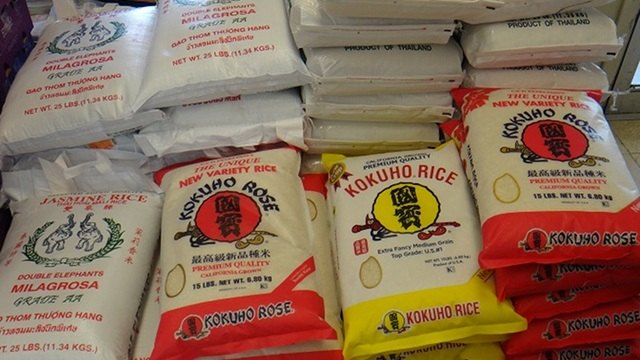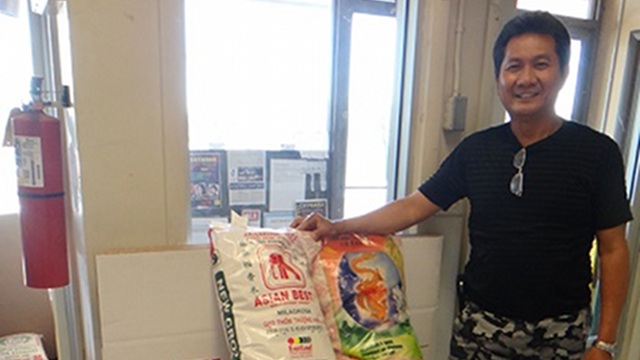SUMMARY
This is AI generated summarization, which may have errors. For context, always refer to the full article.

NEW JERSEY, USA – Sacks of Thai ‘milagrosa’ decorated with pictures of elephants lay beside Jasmine rice in one side of the Phil-Am Colonia grocery store in the Colonia section of Woodbridge.
Next door is a turo-turo and buffet restaurant that is the go-to destination during weekends for the tens of thousands of Filipino-Americans who live in Central New Jersey just outside New York city.
For these Filipinos, the rice of choice is Asian — more pointedly, Thai or Vietnamese rice.
“All of our rice comes from Thailand,” Gil Aguila, who founded the restaurant and store almost 23 years ago in 1990, told Rappler in an interview in his small office.
“We tried American rice. But it never became popular among our customers.”

Mang Gil said he has about 5 to 6 suppliers of the 5- to 10-pound sacks of rice from Thailand stacked in his department store. He estimates the store and restaurant will consume about 500 to 600 sacks in a month.
Imports by the United States of rice from Thailand, Vietnam and India have steadily grown over the years, and analysts believe it is being stoked by an expanding population of Asian-Americans.
Rice imports from Vietnam alone have reached nearly 50,000 metric tons in the 2012/13 marketing year (August/July), the U.S. Agriculture Department says. That is a record with a full quarter to go before the season is out.
“I think maybe it is because the Asians like their own (rice) and will buy it,” Jack Scoville, an analyst for the brokerage Price Futures Group who is a regular contributor to the Philippine Commodities Digest, said in an interview with Rappler.
Scoville is an active trader in the Chicago grains market, the world’s biggest, and he follows the rough rice futures market there.
Aguila said the likely reason why Asians would prefer rice shipped in from halfway around the world comes down to “taste and texture.” He added that cultural habits favoring rice from Asia are deeply ingrained.
“There are differences between each (rice) origin in taste and cooking consistency. Basically Asians know Asian rice and prefer it,” Scoville explained.
By the same token, other groups would prefer American rice. The top export markets for U.S. rice are mostly in the Americas. They include Mexico, Haiti, Canada and Venezuela.
“The Haitians prefer U.S. rice even if it costs more because for them, it tastes better and they know how to cook it,” Scoville said, adding Asian rice has “traditionally been a hard sell in this part of the world.”
But analysts believe U.S. rice imports can only grow as the number of Asian-Americans swell in the years ahead.
Asian-Americans, according to the U.S. Census, now make up about 3% of the U.S. population of over 300 million people. U.S. Census projects that Asian-Americans will eventually account for 10% of the American population in a few decades.
“We have always imported rice and remained an exporter as well, a rather unique position as most do one or the other” Scoville said.
“I think the Asian demand from here goes primarily to the Asian market.” Aguila said he buys a small amount of Goya rice to cater to his Latino customers who find an affinity with Filipino dishes like adobo or crispy pata (deep fried pork hocks) since both viands are familiar in having a common Spanish heritage.
His orders for Thai rice will not be changing anytime soon, he added. “Our customers are 95% Asian,” Aguila said. – Rappler.com
Note: Rene Pastor is with Philippine Commodities Digest, a weekly publication of New Jersey-based A & V Media that provides a comprehensive roundup of developments and trends in the country’s key farming and mining sectors. He is a freelance journalist who worked with the news agency Reuters for nearly 23 years. He graduated with a Masters degree in International Affairs from the New School in New York city and received a bachelor of arts in Communications from the Ateneo de Manila University. Rene is also a lecturer at Middlesex County College in Edison, New Jersey.
Add a comment
How does this make you feel?
There are no comments yet. Add your comment to start the conversation.